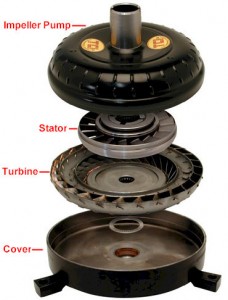Torque converter — a torque converter is an integral part of an automatic transmission, basically a fluid-coupling device that also acts as a torque multiplier during initial acceleration.

Courtesy of TCI
The torque converter consists of four primary components:
Cover — the cover (also referred to as a front) is the outside half of the housing toward the engine side from the weld line. The cover serves to attach the converter to the flywheel (engine) and contain the fluid. While the cover is not actively involved in the characteristics of the performance, it is important that the cover remain rigid under stress (torsional and thrust stress and the tremendous hydraulic pressure generated by the torque converter internally.)
Turbine , The turbine rides within the cover and is attached to the drive train via a spline fit to the input shaft of the transmission. When the turbine moves, the car moves.
Stator. The stator can be described as the “brain” of the torque converter, although the stator is by no means the sole determiner of converter function and characteristics. The stator, which changes fluid flow between the turbine and pump, is what makes a torque converter a torque converter (multiplier) and not strictly a fluid coupler.
With the stator removed, however, it will retain none of its torque multiplying effect. In order for the stator to function properly the sprag must work as designed: (1) It must hold the stator perfectly still (locked in place) while the converter is still in stall mode (slow relative turbine speed to the impeller pump speed) and (2) allow the stator to spin with the rest of the converter after the turbine speed approaches the pump speed. This allows for more efficient and less restrictive fluid flow.
The sprag is a one-way mechanical clutch mounted on races and fits inside the stator while the inner race splines onto the stator support of the transmission. The torque multiplier effect means that a vehicle equipped with an automatic transmission and torque converter will output more torque to the drive wheels than the engine is actually producing. This occurs while the converter is in its “stall mode” (when the turbine is spinning considerably slower than the pump) and during vehicle acceleration. Torque multiplication rapidly decreases until it reaches a ratio of 1:1 (no torque increase over crankshaft torque.) A typical torque converter will have a torque multiplication ratio in the area of 2.5:1. The main point to remember is that all properly functioning torque converters do indeed multiply torque during initial acceleration. The more drastic the change in fluid path caused by the stator from its “natural” return path, the higher the torque multiplication ratio a given converter will have. Torque multiplication does not occur with a manual transmission clutch and pressure plate; hence the need for heavy flywheels, very high numerical gear ratios, and high launch rpm. This is just a brief overview as the actual scenarios are endless.
Impeller pump. The impeller pump is the outside half of the converter on the transmission side of the weld line. Inside the impeller pump is a series of longitudinal fins, which, drive the fluid around its outside diameter into the turbine, since this component is welded to the cover, which is bolted to the flywheel. The size of the torque converter (and pump) and the number and shape of the fins all affect the characteristics of the converter. If long torque converter life is an objective, it is extremely important that the fins of the impeller pump are adequately reinforced against fatigue and the outside housing does not distort under stress.
To be continued…..GotTransmissions.com @ 866-320-1182. Call now for quality replacement transmissions. Join our free blog to continue learning more about transmission’s and torque converters.


